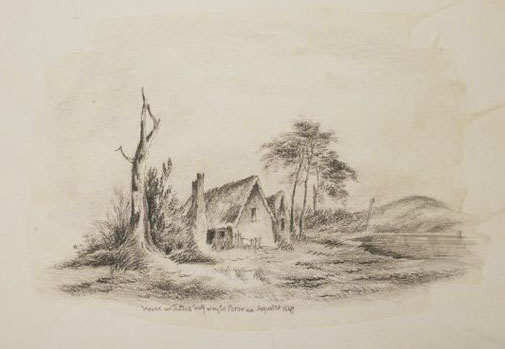
1803?-1897. Deposited in the Wall collection, Alexander Turnbull Library, New Zealand.
Ref: A-100-001. Alexander Turnbull Library, Wellington, New Zealand. http://natlib.govt.nz/records/23075603

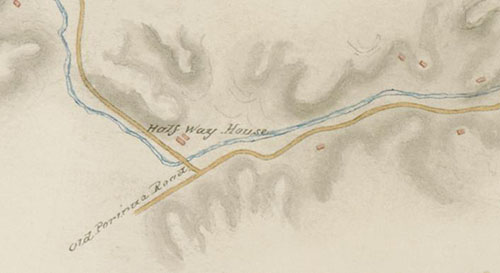
Map showing the Halfway House on the Porirua Road, north of Johnsonville. This near the entrance to Twigland Gardeners World today. It was drawn when the Porirua Road was being upgraded, hence the reference to the old part of the road (now Glenside Road).
Date: 1846-1849 By: Fitzgerald, Thomas Henry, 1824-1888
Alexander Turnbull Library Ref: MapColl-832.47gmbd/[1849]/Acc.460
The 'old' Halfway House was burned down in an accidental fire in 1891. At the time it was owned by the Brown family and tenanted. In c1880 the Browns had built a new house close by which was also known as the Halfway House, a name it carries to this day.
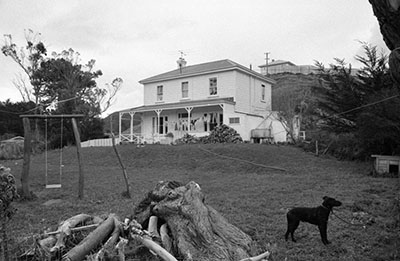
Halfway House in 1968. At this time it was owned by Wellington City Council and tenanted. Photo: Wellington City Council Archives, 1968.
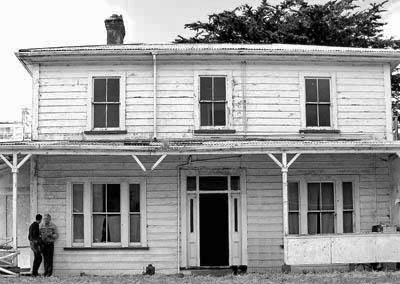
Ross Giblin (left) Jack Crowther (right). Photo: Dennis Hamblin, 2003
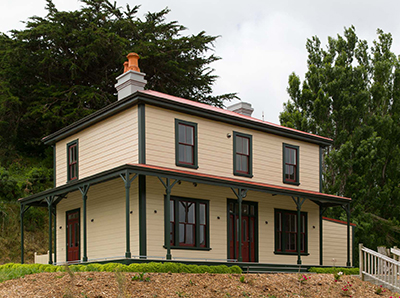
Halfway House. Photo: Neil Price, 2017
What is The Halfway House?
The Halfway House is an old name for Irish, Welsh and English accommodation houses or public inns. These former coaching stops are located at strategic travelling points, usually halfway between two destinations by horse and sometimes on a border between counties. The name came to New Zealand with the 1840 mass immigration of European people.
The first building known as the Halfway House in Glenside (then called "The Halfway") was built in c1840-1841 and occupied by the Wall family. It was built halfway between Wellington and Porirua. It no longer exists. In 1891 newspaper reports describe the 'old' Halfway House burning down. However, before the old Halfway House, which had been tenanted, burned down, a new house was built behind it c1880. This was also known as the Halfway House and is the building which survives today.
Where is it?
The building known as the Halfway House in Glenside is located at 246 Middleton Road, Glenside, behind Twigland Gardeners World on the Glenside Reserve.
Who owns it?
Wellington City Council own it. The existing building, built c1880 and known as the Halfway House, was privately owned until 1951. In 1951 Victoria College (now Victoria University) encroached onto the Wellington Town Belt. Wellington City Council purchased the the Halfway House and associated land with Crown funds paid in compensation for the encroachment. The house was rented out until about 1995 when the last tenant George Poulsen died. It was unoccupied until it was restored and tenanted in 2018.
"The setting of Halfway House is a key element of its heritage value, given its association with the Old Porirua Road and early settlement. The Wellington City Council recognised this when they purchased the property in 1951 and turned it into a reserve. The property retains an atmosphere of isolation and wilderness, and this has been identified as an emotional value associated with the house." Wellington City Council website, 2016.
Since the 1950's, the Glenside Progressive Assn. Inc. had been concerned about the way the Wellington City Council has been managing the Glenside Reserve and Halfway House and has been raising these concerns with the Wellington City Council.
These concerns intensified during 2001-2011. This was because the house was not tenanted or being looked after. At the same time, the Wellington City Council was consulting on the Northern Growth Management Framework and the Assn. could see the potential for the Glenside Reserve and Halfway House to have a more prominent place in the community. During these years the Assn. made many submissions and representations to the City Council and Councillors in an effort to get the house renovated for public use.
Renovations commenced in 2012 and were completed in 2017.
Vision
The Glenside community vision is to work with Council in managing the future of the house, to develop the grounds as a Victorian farm garden using heritage plants and flowers, and to promote the house and grounds as an attractive and interesting place for visitors.
What is the heritage status of the Halfway House?
The Halfway House is listed on the Wellington District Plan as an historic site.
In 2010 the Historic Places Trust received a paper from the Glenside Progressive Assn. Inc. to have the building assessed for a Historic Category rating.
The Trust advised it was unable to progress the Halfway House nomination for registration due to its current resourcing levels and wrote that the nomination will remain on file in the event circumstances change.
Information provided by the Association has been recorded in the Historic Paces Trust register database and will be kept a part of the Historic Places Trust records.
What is happening with the Halfway House?
In 2012 the Wellington City Council began restoration work on the Halfway House. There was a set-back in October 2015. Just days before renovations were due to be signed off, a crimped fire sprinkler pipe in the ceiling burst free and for three days water flooded the house. In the last week of February 2017, renovations recommenced. The house was officially opened on 29 October, 2017. Wellington City Council sought registrations of interest from people interested in leasing the house. It is currently occupied by the leaders of Challenge 2000, a youth development initiative. The downstairs front rooms remain available for community use. In 2021 the rooms were advertised for hire, suitable for small meetings, at the standard City Council rate.
What is happening with the grounds?
The grounds are managed in partnership by the Halfway House Heritage Gardeners, who are creating an early settler Victorian farm garden, and the Wellington City Council.
What does Wellington City Council propose for the house?
The Council proposes to:
Retain ownership of the building but find a suitable long-term use for it.
Carry out essential maintenance and work to make the house safe.
Lease the building for public good (recreation, leisure, community, cultural or education).
Develop a car-park (which has since been completed).
Recreate a garden in keeping with heritage and character and place historic interpretation panels.
Why is there a Halfway House in Glenside?
Glenside was known as The Halfway from c1840-1928. The name was given to the area because it was located on the main route halfway between Wellington and Porirua.
Early settlers Anthony and Susannah Wall settled in the area in the spring of 1841 and provided accommodation for travellers passing by. It was the first Halfway House in the locality.
After the Wall's left the area, history records six different proprietors operating a Halfway House in the Halfway (Glenside) up until c1900. By 1900 the railway line had opened taking travelers by steam train direct to towns, by-passing the former horse and coach route.
These are the known proprietors of the Halfway House
1841 - 1849 Suzannah (nee Dowdeswell) and Anthony Wall
1849 - 1853, 1855 Harriet (nee Maynard) and John Ward McKain
1855 - 1857 Sarah (nee Tomliens) and Joseph Clapham
1857 - 1865 Mary Ann (nee Bould) and William Thomas Clapham
1866 - 1871 Elizabeth (nee Clapham) and William Edwards
1871 - 1890 Margaret (nee Clarkson) and Alexander ‘Sandy’ Brown
Where was the first Halfway House located?
The Wall family lived at The Halfway from 1841-1849. There are different opinions about the location of the Wall’s house. The page 'Halfway House Location' on this website explains the details.
What do we know of the current Halfway House in Glenside?
Writers have different opinions about whether the Halfway House on the Glenside Reserve was originally used for a Halfway House business or was a private residence for Alexander Brown and his wife Margaret. Newspaper advertising of the time suggest the existing house, known as The Halfway House, was once called Gowan Bank.
What people do agree is that Alexander 'Sandy' Brown built it in about 1880 and that he was a licensee who operated a Halfway House in The Halfway, now called Glenside. Brown's descendants say that Alexander operated a hostelry (public inn and accommodation) and way station (place for checking goods in transit) for stage coaches passing along the main road.
An interesting fact
The existing Halfway House (c1880) is located very close to where McKain's Halfway House was located in 1849. A map drawn by Thomas Henry Fitzgerald in 1849 for Captain A H Russell marks the location of a building called The Halfway House (see map above). Today this location is about where Twigland Gardeners World entrance is, or perhaps it was behind Twigland's, where the ground rises at the base of the hill.
The owner of a private home opposite Twigland Gardener's World found many old horseshoes in her garden, suggesting that at a later time there may have been a blacksmith located opposite the Halfway House marked on Mr Fitzgerald's 1849 map.
